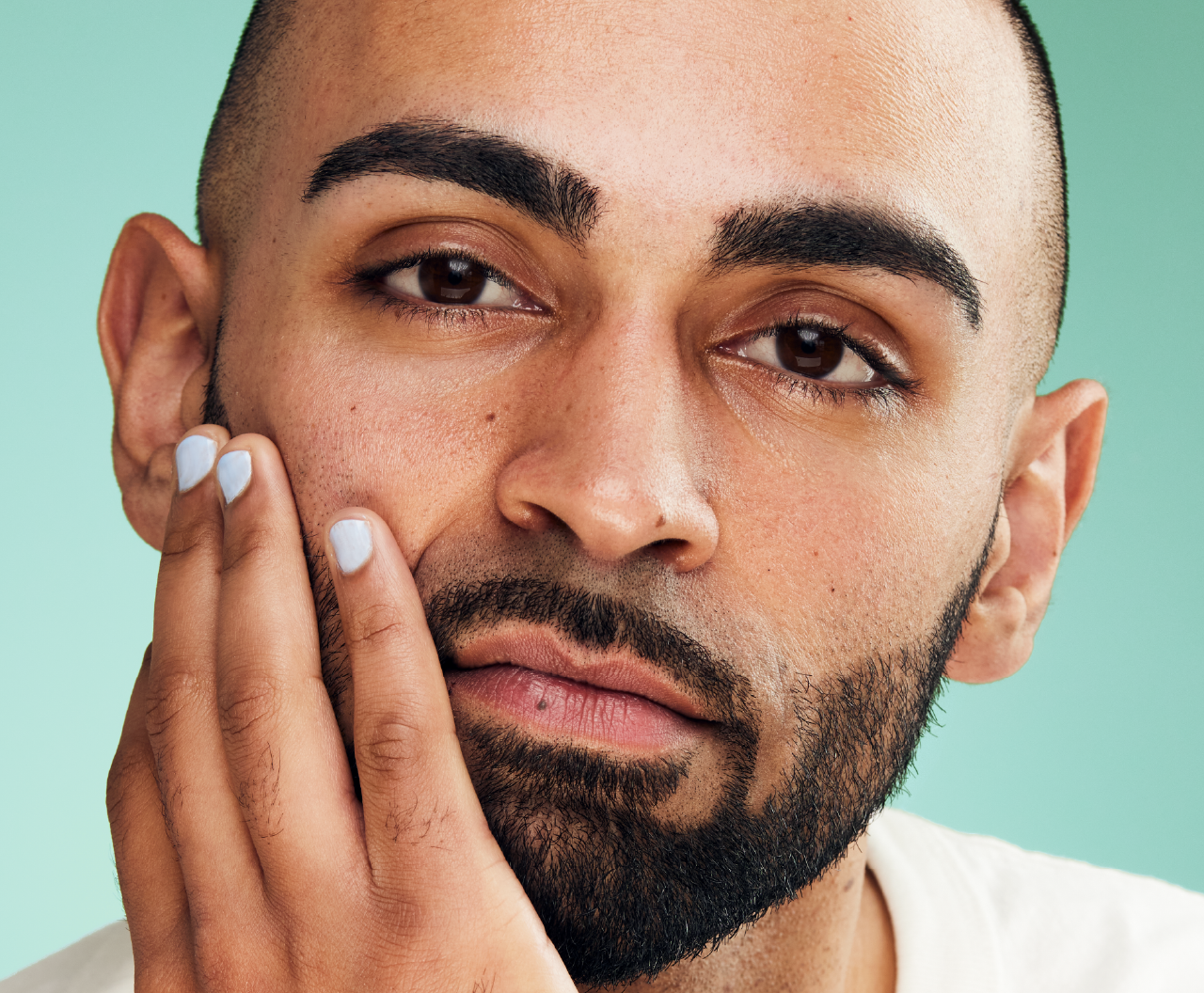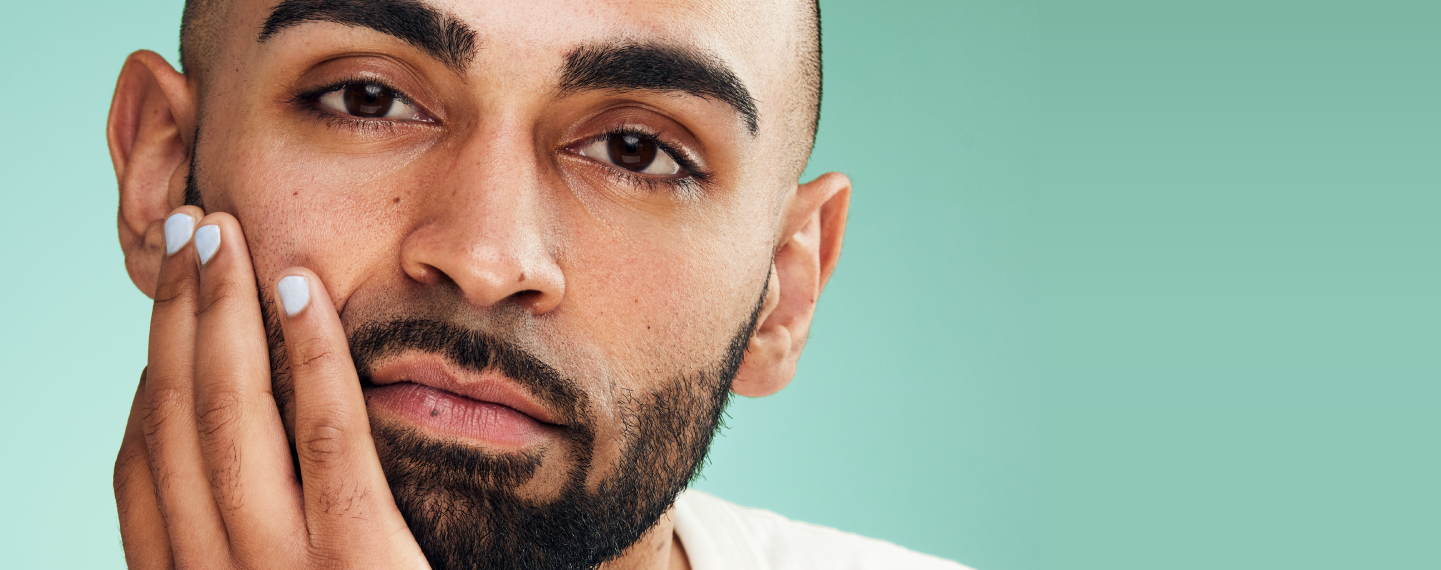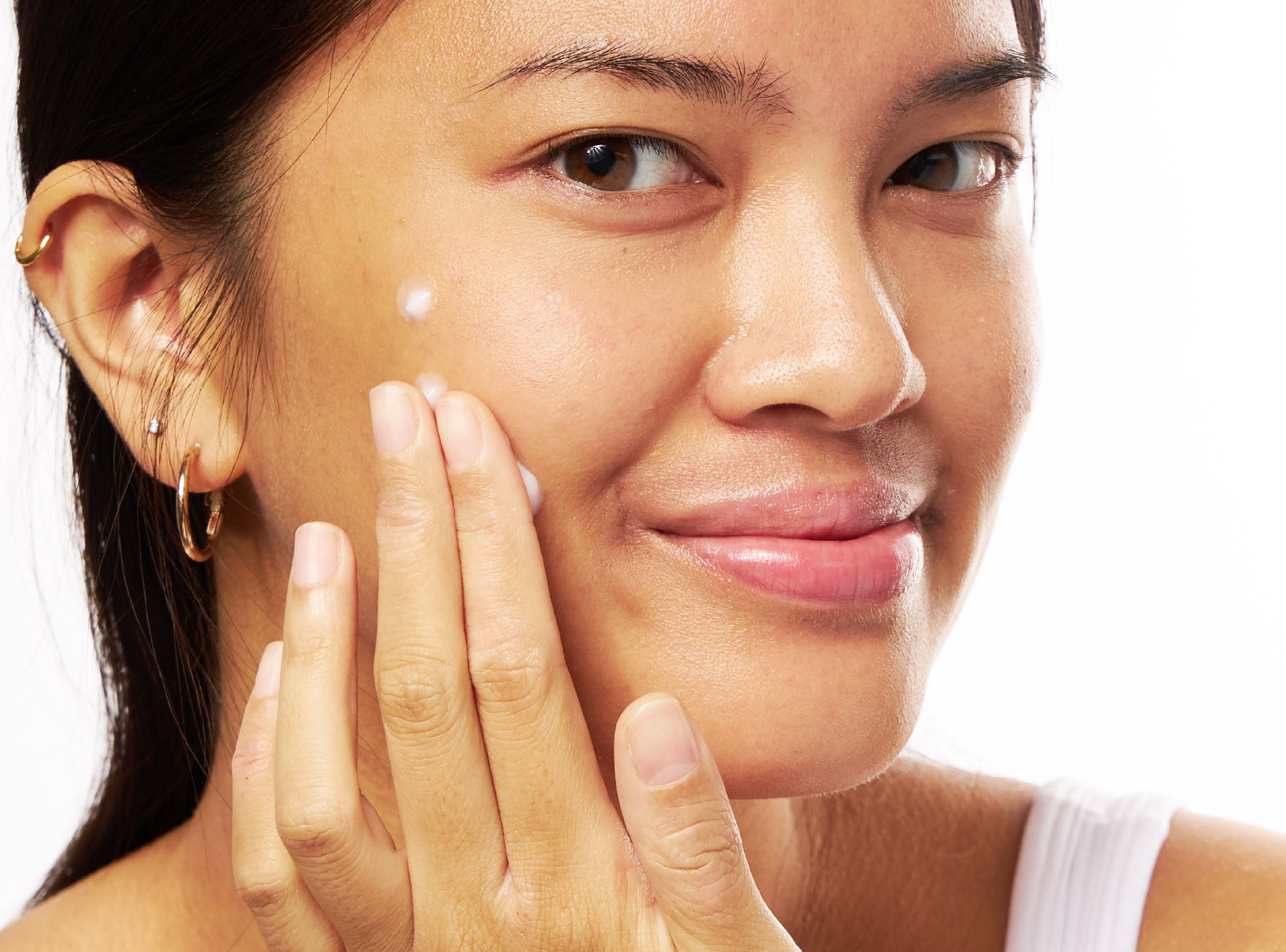General
Are You A Man With Acne? Read on.


SHARE
General
Are You A Man With Acne? Read on.
Medically reviewed by Aimee Paik, MD
Written by Apostrophe Team
Last updated 2/1/2023
Let’s be real: most skincare and beauty marketing is targeted at women. Skincare ads love to show a woman delicately splashing water on her face or laughing as she shows off perfectly moisturized legs. Men aren’t as encouraged to seek out solutions for their skincare woes, even though they can also suffer the stigma of acne and breakouts. We asked dermatologist, Dr. Mamina Turegano, to give us the inside scoop on male-specific skin issues and what you can do about them!
If it’s not hormonal…
We know one of the most common causes of adult acne in women is fluctuating hormones levels that typically occur right before their periods. But what’s up for men who don’t experience these types of fluctuations? Dr. Turegano says that although genetics can play a role, sometimes a bigger factor can be what you’re putting in your body.
“I notice a pattern in men who get into the groove of working out at the gym more regularly and increase their consumption of whey protein and/or milk or other possible supplements that can boost testosterone,” she states. “I'm a big believer that (in addition to dairy foods) processed foods – foods with increased white sugar, high fructose corn syrup, and processed genetically modified grains – can contribute to acne in all ages.” Incorporating more fruits, veggies, and whole grains may help curb those pesky breakouts.
A clean shave = breakouts?
Shaving can cause irritation, ingrown hairs, and breakouts anywhere on your body, but it can be especially annoying when it happens on your face. Luckily for the fuzzier folks out there, there are a few tips and tricks you can try to avoid irritation caused by shaving. Dr. Turegano suggests, “Prior to shaving, hydrate your beard for a few minutes with warm water or steam (like in the shower) to open the pores. While shaving, shave in the same direction as the hair growth (with the grain) as much as you can, and avoid going against the grain unless that is the only way to get a close shave.
Immediately after shaving, I sometimes recommend applying a prescription antibiotic solution, almost like an aftershave. I have men on a regular retinoid regimen to keep the skin exfoliated and prevent the follicles from turning into raised bumps as a result of a buildup of skin cells or a weirdly-angled hair shaft that causes irritation after shaving.” Of course, you can always toss the razor in exchange for going au naturale!
The Best Acne Treatments for Men
Treating acne can seem complicated, but it’s usually fairly straightforward once you identify the causes of your acne and take targeted action to bring them under control.
As we’ve discussed in our guide to adult acne, acne develops when your hair follicles, or pores, become clogged with a mix of sebum and dead skin cells.
These clogged pores can form into whiteheads, blackheads or infected forms of acne, such as pimples, nodules and cystic acne.
A variety of different factors play a role in this process, including things like your production of certain hormones, stress and your skin care habits.
For most guys, the right combination of skin care products and a good skin care routine can treat even the toughest, most severe acne breakouts.
Tretinoin
Tretinoin is a topical retinoid -- a type of medication that’s derived from vitamin A. It’s one of the most well-known and well-researched medications for acne in the world, with numerous studies showing that it can treat everything from mild to severe breakouts.
As a retinoid, tretinoin works by unclogging your pores and speeding up your body’s production of new skin cells. This helps to get rid of acne and stop breakouts from coming back.

PRESCRIPTION TRETINOIN
Target acne, dark spots, and signs of aging with this science-backed ingredient.
Many dermatologists prescribe tretinoin and it’s one of the ingredients that could be in your customized Apostrophe Topical Acne Cream. It takes around three months for it to produce a noticeable improvement in your skin, during which you may experience some extra dryness, irritated skin and persistent acne — known commonly as the “Tretinoin Purge.”
An added bonus of tretinoin is that it also has anti-aging effects, with research showing that it’s effective at reducing the appearance of wrinkles and improving skin texture.
Our Tretinoin 101 guide goes into greater detail about how tretinoin works, its uses, side effects and more.
Other Retinoids
In addition to tretinoin, several other topical retinoids are used to treat acne breakouts, including adapalene and retinol.
These ingredients aren’t quite as powerful as tretinoin, but they may be worth considering if you only get mild acne breakouts. Unlike tretinoin, both are available without a prescription.
Retinol is a mild retinoid that’s mostly used for anti-aging purposes. Although research is limited, some studies have found that it helps to get rid of acne when it’s used in combination with other ingredients.
Adapalene is a slightly more powerful retinoid. Research shows that it’s less likely to cause side effects than tretinoin, meaning it may be a good option if you have sensitive skin.
You can find retinol and adapalene in numerous over-the-counter skin care products. Adapalene is available in a mild form as Differin® gel.
Retinol and adapalene are good options if you have mild acne and oily skin, as they can help to clear up breakouts while causing a slight reduction in sebum (oil) production.
Our adapalene vs. tretinoin guide goes into more detail about how milder retinoids stack up next to tretinoin when it comes to efficacy, side effects and overall results.
Benzoyl Peroxide
Benzoyl peroxide is a key ingredient in over-the-counter cleansers, facial washes and other skin care products designed to get rid of acne. It works by preventing the growth of bacteria that can cause acne to become infected and painful.
Several studies have found that benzoyl peroxide reduces the severity of acne, especially acne that’s inflamed and swollen.
Benzoyl peroxide can cause some side effects, including skin dryness, peeling and a tingling or stinging sensation that affects your skin.
Since benzoyl peroxide doesn’t require a prescription, it’s a good first choice if you get pustules, papules and other forms of inflammatory acne.
Hydroxy Acids (AHAs and BHAs)
Alpha-hydroxy acids (AHAs) and beta-hydroxy acids (BHAs) are common types of exfoliants, or peeling agents. They work by loosening and removing the outermost layer of your skin, which is made up of dead skin cells.
Popular hydroxy acids include glycolic acid, lactic acid and salicylic acid. You can find AHAs and BHAs in many over-the-counter facial washes, creams and acne spot treatments.
These ingredients are also used in much stronger forms in skin peeling procedures provided by plastic surgeons and dermatologists.
Using a hydroxy acid product may be a good option if you’re prone to comedonal acne, such as whiteheads and/or blackheads.
Niacinamide
Niacinamide is a form of vitamin B3 that’s often found in skin care products. It offers a range of benefits, including improved epidermal barrier function -- your skin’s ability to prevent infection and retain moisture.
Although it’s best known for its anti-aging effects, niacinamide may also be effective at keeping acne breakouts at bay.
In a review published in the journal Dermatologic Therapy, researchers looked at eight studies of topical niacinamide as an acne treatment, noting that six studies involved reductions in acne severity.
You can find niacinamide in any good acne face wash, cream and other acne treatments, often alongside ingredients such as benzoyl peroxide.
Clindamycin
Clindamycin is a prescription topical antibiotic. It works by reducing swelling and preventing the bacteria that cause acne from multiplying on your skin and inside your pores.
Your healthcare provider may prescribe clindamycin, either on its own or with other medication, if you have inflamed acne that doesn’t get better with over-the-counter treatments.
Along with tretinoin and several other ingredients, clindamycin is an important active ingredient that could be in your Apostrophe Customized Acne Cream.
Clindamycin is one of the most effective antibiotics for acne, with research dating back several decades showing that it can get rid of pimples and prevent breakouts from coming back.
We’ve discussed this research and other important information about clindamycin in our guide to clindamycin for acne.
Oral Antibiotics
If you have moderate or severe acne that doesn’t seem to get better with topical antibiotics like clindamycin, your healthcare provider may prescribe an oral antibiotic.
Like topical antibiotics, these medications work by stopping acne-causing bacteria from growing on your skin. This type of medication is usually prescribed for use with benzoyl peroxide, topical retinoids or a combination of other treatments.
Popular oral antibiotics for acne include tetracycline, doxycycline, minocycline, azithromycin and erythromycin.
Since overuse of antibiotics can lead to bacterial resistance (an issue that can make acne worse and harder to treat), you’ll need to closely follow your healthcare provider’s instructions if you’re prescribed an oral antibiotic.
Isotretinoin
When acne is severe, many dermatologists will prescribe isotretinoin -- an oral medication that can get rid of even the toughest acne breakouts, often for good.
When it comes to efficacy, isotretinoin is arguably the best acne treatment for men. It works for almost all acne, even severe nodular or cystic acne that doesn’t improve with topical treatments such as benzoyl peroxide, tretinoin and/or clindamycin.
Some research even shows that short-term treatment with isotretinoin can permanently prevent acne breakouts from coming back.
While isotretinoin is effective, it can cause side effects, including dry cracked lips, peeling skin, nosebleeds and others.
It can also cause health issues that aren’t externally visible, such as elevated liver enzymes or cholesterol levels.
To keep yourself safe, you’ll need to check in with your healthcare provider on a regular basis if you’re prescribed this medication.
Good Skin Care Habits
Finally, although they’re not a “treatment” in the typical sense, good skin care habits play a key role in getting rid of acne and preventing it from coming back.
These include washing acne-prone skin regularly (the AAD recommends twice a day), avoiding touching your face throughout the day, washing your hair regularly to prevent excess sebum buildup, using gentle skin care products and protecting your healthy skin from bright sunlight.
It’s also important not to pop your pimples by yourself, as this can push debris deeper into your skin and make your breakouts worse.
We’ve covered the lifestyle factors that can contribute to acne, as well as the steps that you can take to prevent them from affecting you, in our guide to taking care of your skin.
Which Acne Treatment is Best For You?
Since acne can vary hugely in severity, from mild breakouts to inflamed and painful cystic acne, there’s no “best” acne treatment for everyone.
Instead, the best acne treatment for you depends on the severity of your acne, the changes that you’re willing to make to your skincare routine, your tolerance for side effects and several other factors.
If you have mild acne, you’ll likely see improvements from over-the-counter treatments such as benzoyl peroxide, retinol, adapalene and/or exfoliants such as hydroxy acids.
Although these treatments aren’t the most powerful on the market, they’re generally effective at getting mild acne breakouts under control.
Finally, if you have moderate to severe acne that doesn’t improve with other treatments, you may want to talk to a dermatologist about options such as oral antibiotics and/or isotretinoin.
These medications are powerful, effective and often used specifically for acne that’s challenging to treat.
Our guide to prescription acne medication talks about these medications, their effects and when they’re best used in more detail.
In Conclusion - Finding the Best Acne Treatment for Men
Acne is a frustrating, common skin condition that affects us all from time to time, whether it’s in adolescence or adulthood.
From over-the-counter treatments like benzoyl peroxide to prescription acne medications such as isotretinoin, countless options are available for stopping acne breakouts and helping you to enjoy clear, pimple-free healthy skin.
To get started treating acne, you can visit your local drugstore or get started with Apostrophe skin care products online to connect with an expert derm team for your acne.
Good skincare is for everyone! Making small changes to your routine and talking to a dermatology provider about the best treatments for you can set you on the path to healthier, brighter, and clearer skin.
16 Sources
Collier, C.N., et al. (2008, January). The prevalence of acne in adults 20 years and older. Journal of the American Academy of Dermatology. 58 (1), 56-59. Retrieved from https://www.sciencedirect.com/science/article/abs/pii/S019096220701081X
Leyden, J., Stein-Gold, L. & Weiss, J. (2017, September). Why Topical Retinoids Are Mainstay of Therapy for Acne. Dermatology and Therapy. 7 (3), 293–304. Retrieved from https://www.ncbi.nlm.nih.gov/pmc/articles/PMC5574737/
Yoham, A.L. & Casadesus, D. (2020, December 5). Tretinoin. StatPearls. Retrieved from https://www.ncbi.nlm.nih.gov/books/NBK557478/
Garofalo, V., Cannizzaro, M.V., Mazzilli, S., Bianchi, L. & Campione, E. (2019). Clinical evidence on the efficacy and tolerability of a topical medical device containing benzoylperoxide 4%, retinol 0.5%, mandelic acid 1% and lactobionic acid 1% in the treatment of mild facial acne: an open label pilot study. Clinical, Cosmetic and Investigational Dermatology. 12, 363–369. Retrieved from https://www.ncbi.nlm.nih.gov/pmc/articles/PMC6526677/
Villani, A., et al. (2020, October). Efficacy and safety of a new topical gel formulation containing retinol encapsulated in glycospheres and hydroxypinacolone retinoate, an antimicrobial peptide, salicylic acid, glycolic acid and niacinamide for the treatment of mild acne: preliminary results of a 2-month prospective study. Giornale Italiano di Dermatologia e Venereologia. 155 (5), 676-679. Retrieved from https://pubmed.ncbi.nlm.nih.gov/32869963/
Matin, T. & Goodman, M.B. (2020, November 24). Benzoyl Peroxide. StatPearls. Retrieved from https://www.ncbi.nlm.nih.gov/books/NBK537220/
Kawashima, M., Nagare, T. & Doi, M. (2017, November). Clinical efficacy and safety of benzoyl peroxide for acne vulgaris: Comparison between Japanese and Western patients. The Journal of Dermatology. 44 (11), 1212–1218. Retrieved from https://www.ncbi.nlm.nih.gov/pmc/articles/PMC5697687/
Benzoyl Peroxide Topical. (2015, August 15). Retrieved from https://medlineplus.gov/druginfo/meds/a601026.html
Like what you just read? Sign up for our email list to get the scoop on skincare science delivered straight to your inbox.

General
What is milia?
What is milia? Today, we’re jumping into one type of bump that you may have heard about most commonly in infants — milia.
Read More
General
Best moisturizer for acne-prone skin
If you have combination acne-prone skin, figuring out which moisturizer is best for your skin might be tough. In this guide, we break down the best moisturizer for combination, acne-prone skin.
Read More
General
How to build a face care routine
As you get into skincare, it might seem overwhelming, especially trying to figure out the order you're supposed to apply products in. Below, we detail how to build a face care routine for your skin!
Read More
